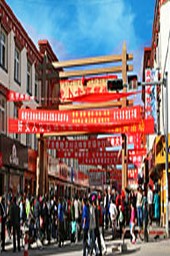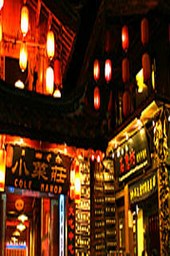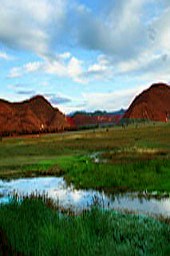|
|
|
Добро пожаловать в Шангри-Ла
По приказу госсовета КНР
Красные неоновые трубки освещают путь в караоке-бар в отеле Paradise в
Шангри-Ла, где гостям предлагают купить общество хозяек: 100 юаней (7 фунтов)
- за час совместного пения, 200 юаней - за танец...
Это - вероятно не то, что Джеймс Хилтон имел в виду, когда он придумывал
Шангри-Ла в романе ''Утерянный Горизонт'' 1933 года.
Однако - редкий по смелости случай в истории - этот захудалый, но расположенный в живописном месте в
Гималаях город был переименован в честь выдумки британского писателя и
назначен туристическим раем по приказу китайского правительства...
Welcome to Shangri-La.
By order of the state council of the Chinese government
Flashing red neon tubes light up the way to the karaoke bar in Shangri-La's
Paradise hotel, where guests are invited to buy the company of hostesses: 100
yuan (₤7) to sing for an hour, 200 yuan for a shared dance.
Five minutes further on is the Shangri-La "Old Town", built from scratch
in the past two years. The elegantly carved wooden buildings are already
full of trinket sellers offering fluffy yaks, prayer beads and ceremonial
daggers, while black-market hawkers walk the cobbled streets touting fake
Rolex watches and Ray-Ban sunglasses.
It is probably not what James Hilton had in mind when he dreamed up Shangri-La
in his 1933 novel Lost Horizon. But, in one of the most audacious rebranding exercises
in history, this scruffy but spectacularly located Himalayan town has been renamed after
the British author's fictional utopia and designated a tourist paradise by order of the
Chinese government.
The transformation of this once remote community into a sightseeing hub is part of a
new phase of China's economic expansion, which is taking the modernisation drive into
some of the most remote places on earth, reducing poverty but ruining the environment.
For most of the past 50 years, this fertile plain, ringed by snow-capped mountains
and home to a rich mix of ethnic communities, was designated as Zhongdian, a county
in the Diqing Tibetan autonomous prefecture of north-west Yunnan prefecture.
That title was never likely to attract visitors. So after the Cultural Revolution,
local officials lobbied the central government to change the name. They faced stiff
competition from other Himalayan regions, which also claimed to be source of inspiration for Hilton.
The ensuing contest to be the official utopia lasted the better part of a decade, until
the state council announced in 2001 that Xiang-ge-ri-la - the Mandarin rendition of Shangri-La -
was to be marked on all maps in the place previously occupied by Zhongdian.
Now that paradise has been found, it has been overrun. In the year before the name-change, Shangri-La
received 20,000 visitors. Last year, the number surged to 2.6 million. Formerly inaccessible except
by a mountain road, the town can now be reached by flights to the new Zhongdian airport, which
is being expanded in the expectation of a tripling of visitors over the next 15 years.
This is putting enormous pressure on the environment. Shangri-La is the gateway to the Three
Parallel Rivers national park, a world heritage site where three of Asia's great waterways -the
Yangtze, Mekon and the Salween - run within 50 miles of each other. Nature Conservancy,
a US-based NGO, says this is among the most diverse temperate regions in the world with more than
7,000 plant species and climates ranging from subtropical to alpine.
But tour buses now speed through the grasslands formerly occupied only by wild boar and yaks.
Cable cars have been built on the azalea-bedecked hillsides and new hotels are under construction.
Among the new arrivals is the upmarket Banyan Tree resort, which is fully booked for the next two
months despite a starting price of more than ₤200 a room. At 3,500 metres (11,500ft) above sea level
many guests need to be given oxygen to fend off altitude sickness.
Local officials welcome the economic benefits that tourism brings to a formerly impoverished area.
According to the Shangri-La government, revenues have risen sixfold in the past 10 years to more
than 2bn yuan. But they acknowledge that the 60% annual increase in tourist numbers is putting
enormous pressure on the fragile environment.
"Ideally, a growth rate of about 10% a year would be easier to manage, but our government's
priority is to promote economic development and to boost the incomes of local people,"
said A Wa, the head of the Shangri-La tourism bureau. "So we must try to minimise the
impact on the environment. Our aim is to attract more high-income tourists because they
are more conscious of the need to protect the ecology and they are bigger consumers."
But conservationists face a losing battle against the 100 tour operators, hotel chains
and travel agents in Shangri-La that are keen to grab a slice of the 50bn yuan budget
allocated by Beijing to develop tourism in Shangri-La in the next decade. "Overall tourism
is good. If we didn't have this, we would rely on logging or mining, which are more destructive,"
said Ziren Pingcuo, a Tibetan photographer and environmental activist. "But it is hurting the
ecology, it is ruining the atmosphere of sacred places, and not enough of the benefits are passed
on to local people."
It is the same story across China's least developed - and most beautiful - regions, which are
now opening up to foreign visitors and domestic tourists from the wealthy eastern seaboard.
In the past five years, the number of domestic tourist visits has increased from 744 million
to 1.2 billion.
The rural landscape of Shangri-La remains bucolic, but the town is anything but an idyll.
In one restaurant beggars enter to ask for money. A group of soldiers, reluctant to interrupt
a drinking game that has one of them throwing up beside the table, shoos them away. "Don't
bother us. Go and ask the foreigner for money." The closer you get to Shangri-La, the further
it seems from utopia.
Backstory
The first mention of Shangri-La in English appears in James Hilton's 1933 novel
Lost Horizon
to describe an imaginary Himalayan utopia. Hilton never visited the
Himalayas, but is thought to have been inspired by the US explorer Joseph F Rock,
who wrote of the beauty of Yunnan in the 1920s and early 30s. Chinese officials
say the name comes from three characters - shang, meaning heart, ri, sun, and la,
moon - which together symbolise perfect harmony. Tibetans believe it is derived
from the Sanskrit word Shambhala - a spiritual utopia in Buddhism.
Jonathan Watts (01.06.2006) The Guardian
ред. AG & J-MAO
|
|




|
|



